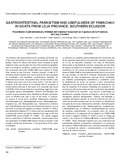Mostrar el registro sencillo del ítem
Parasitismo Gastrointestinal y Utilidad del Sistema Famacha® en Caprinos de la Provincia de Loja, Ecuador
| dc.rights.license | http://creativecommons.org/licenses/by-nc-sa/3.0/ve/ | |
| dc.contributor.author | Jaramillo, Alan | |
| dc.contributor.author | Guzmán, Lucía | |
| dc.contributor.author | Castillo, Lenin | |
| dc.contributor.author | Rodrigo Saa, Luis | |
| dc.contributor.author | Rey Valeirón, Catalina | |
| dc.date.accessioned | 2017-09-20T16:34:20Z | |
| dc.date.available | 2017-09-20T16:34:20Z | |
| dc.date.issued | 2017-05 | |
| dc.identifier.issn | 0798-2259 | |
| dc.identifier.uri | http://www.saber.ula.ve/handle/123456789/43727 | |
| dc.description.abstract | La infección por parásitos gastrointestinales (GI) representa una de las mayores limitaciones en la producción, sanidad y bienestar en la cría de pequeños rumiantes. Con base en información oficial sobre la mortalidad de caprinos relacionada con dos años de sequía, el objetivo de la presente investigación fue evaluar el parasitismo GI, los valores de hematocrito y compararlos con el sistema FAMACHA® en la localidad de Garza Real en la provincia de Loja, Ecuador. Un total de 77 muestras individuales de heces obtenidas en siete explotaciones caprinas fueron analizadas por métodos parasitológicos cuantitativos y cualitativos; para la identificación de larvas, se llevaron a cabo coprocultivos utilizando un pool de heces de cada una de las siete fincas. Del total de muestras, 91% estaban infectadas con parásitos GI. Se encontraron infecciones mixtas con dos a cuatro tipos de parásitos GI en 87,82% de los animales. Con base en la morfología, se identificaron mediante técnicas de flotación, huevos del Orden Strongylida, géneros Strongyloides, Trichuris and Moniezia y ooquistes del género Eimeria. El nivel de infección fue alto en cuatro de las siete explotaciones. En los cultivos, se identificaron seis géneros de larvas: Haemonchus contortus, Trichostrongylus spp., Oesophagostomun spp., Teladorsagia spp., Cooperia spp. y Strongyloides spp., H. contortus y Trichostrongylus spp. fueron las especies predominantes. La correlación entre los valores de hematocrito y la asignación de la categoría en FAMACHA® fue fuerte y negativa (-0,9418; P< 0,001) y entre el contaje de huevos y los criterios en FAMACHA® fuerte y positiva (0,9763; P< 0,005). Estos resultados sugieren que una combinación de tratamientos efectivos, suplementos alimenticios y la aplicación del sistema FAMACHA® debería ser aplicado sistemáticamente en la localidad de estudio y extensivamente, a los rebaños caprinos de toda la provincia. | es_VE |
| dc.language.iso | es | es_VE |
| dc.rights | info:eu-repo/semantics/openAccess | |
| dc.subject | Parásitos gastrointestinales | es_VE |
| dc.subject | FAMACHA® | es_VE |
| dc.subject | Caprinos | es_VE |
| dc.subject | Ecuador | es_VE |
| dc.title | Parasitismo Gastrointestinal y Utilidad del Sistema Famacha® en Caprinos de la Provincia de Loja, Ecuador | es_VE |
| dc.title.alternative | Gastrointestinal Parasitism and Usefulness of Famacha© in Goats From Loja Province, Southern Ecuador | es_VE |
| dc.type | info:eu-repo/semantics/article | |
| dc.description.abstract1 | The infection with gastrointestinal (GI) parasites represents one of the main constraints for small ruminant production, health and welfare. Based on official information about mortality of goats related to a two-year drought, the aim of the present investigation was to evaluate GI parasitism, packet cell volume (PCV) values and compared them with FAMACHA© score system in Garza Real locality at Loja Province, Southern Ecuador. A total of 77 individual faecal samples from seven goat farms were analyzed by quantitative and qualitative parasitological methods; for differential larval count, coproculture were carried out with a pool of faeces from each one of the seven farms. From the total of samples, 91% were found to be infected with GI parasites. A mixed infection with two to four types of GI parasites was found in 87.82% of the animals. Based on morphology, eggs from order Strongylida, genera Strongyloides, Trichuris and Moniezia and oocysts of genus Eimeria were identified by flotation technique. Level of infection was high in four of the farms. In cultures, six genera of larvae were identified: Haemonchus contortus, Trichostrongylus spp., Oesophagostomun spp., Teladorsagia spp., Cooperia spp. and Strongyloides spp., Haemonchus contortus and Trichostrongylus spp. were the predominant species in six of the farms. A strong and negative correlation (-0.9418; P< 0.001) was established between PCV values and score assignment and a strong and positive correlation between fecal egg counts and FAMACHA© scores (0.9763; P< 0.005). The results suggest that a combination of effective treatments, supplementary food and application of FAMACHA© system should be applied in the locality of study and furthermore, in the goat farms of the entire municipality. | es_VE |
| dc.description.colacion | 180-186 | es_VE |
| dc.identifier.depositolegal | pp199102ZU46 | |
| dc.identifier.edepositolegal | ppi201502ZU4665 | |
| dc.identifier.eissn | 2477-944X | |
| dc.publisher.pais | Venezuela | es_VE |
| dc.subject.institucion | Universidad del Zulia (LUZ) | es_VE |
| dc.subject.institucion | Universidad de Los Andes (ULA) | es_VE |
| dc.subject.keywords | Gastrointestinal parasites | es_VE |
| dc.subject.keywords | FAMACHA© | es_VE |
| dc.subject.keywords | Goat | es_VE |
| dc.subject.keywords | Ecuador | es_VE |
| dc.subject.publicacionelectronica | Revista Científica | |
| dc.subject.seccion | Universidad de Los Andes (ULA) | es_VE |
| dc.subject.thematiccategory | Medio Ambiente | es_VE |
| dc.subject.tipo | Revistas | es_VE |
| dc.type.media | Texto | es_VE |
Ficheros en el ítem
Este ítem aparece en la(s) siguiente(s) colección(ones)
-
Revista Científica - 2017 - Vol.XXVII - No. 003
Mayo - Junio 2017


